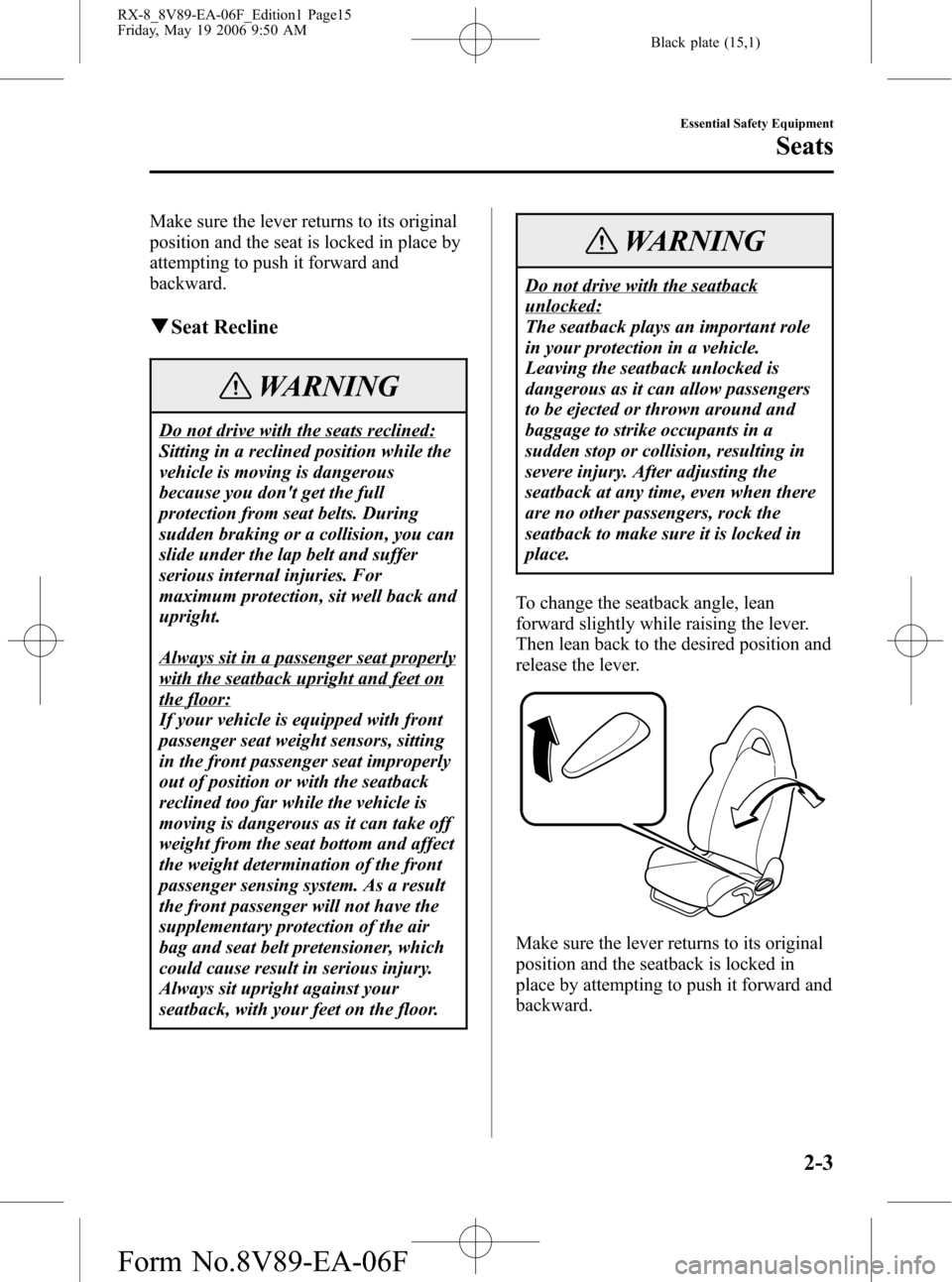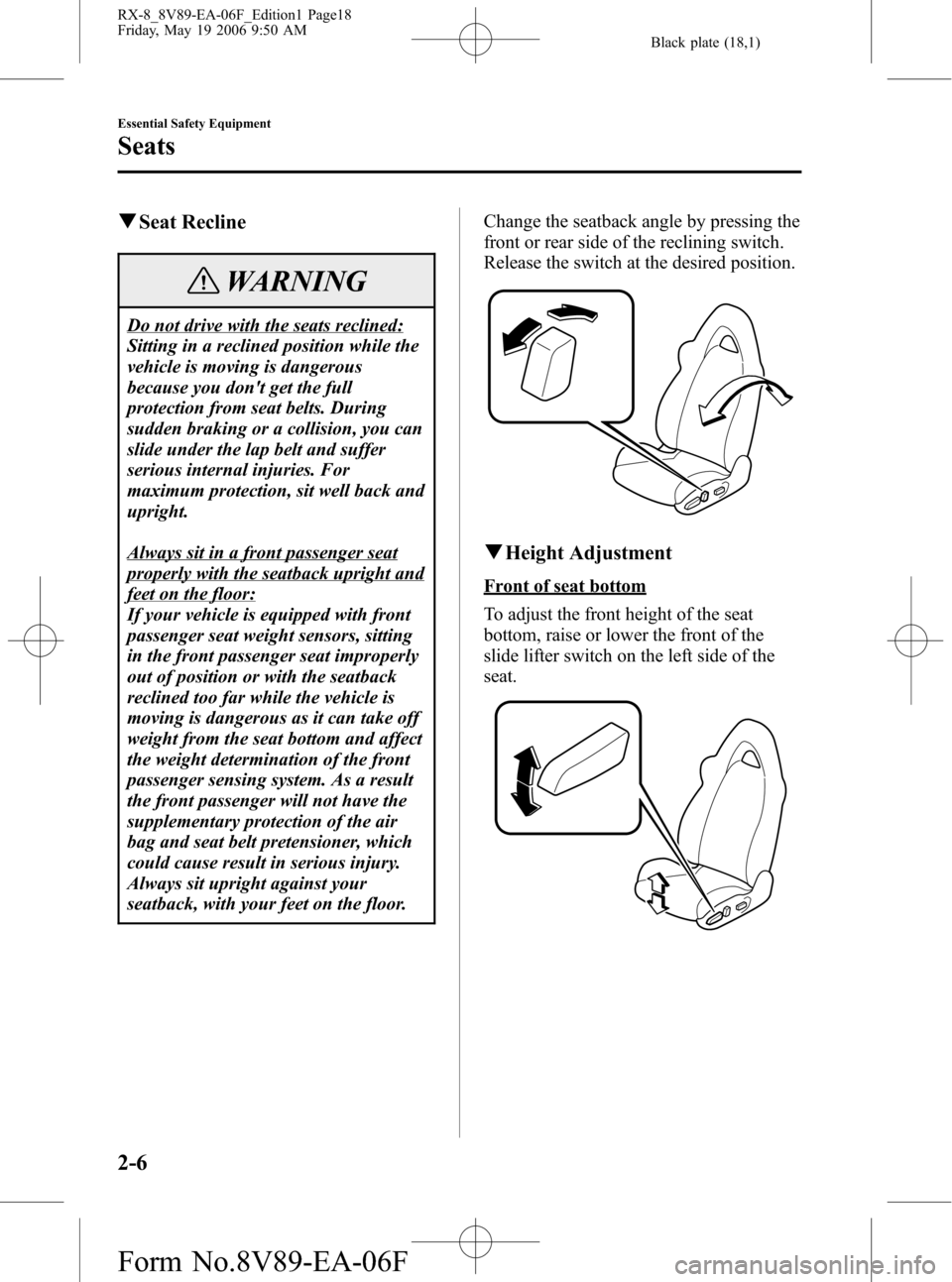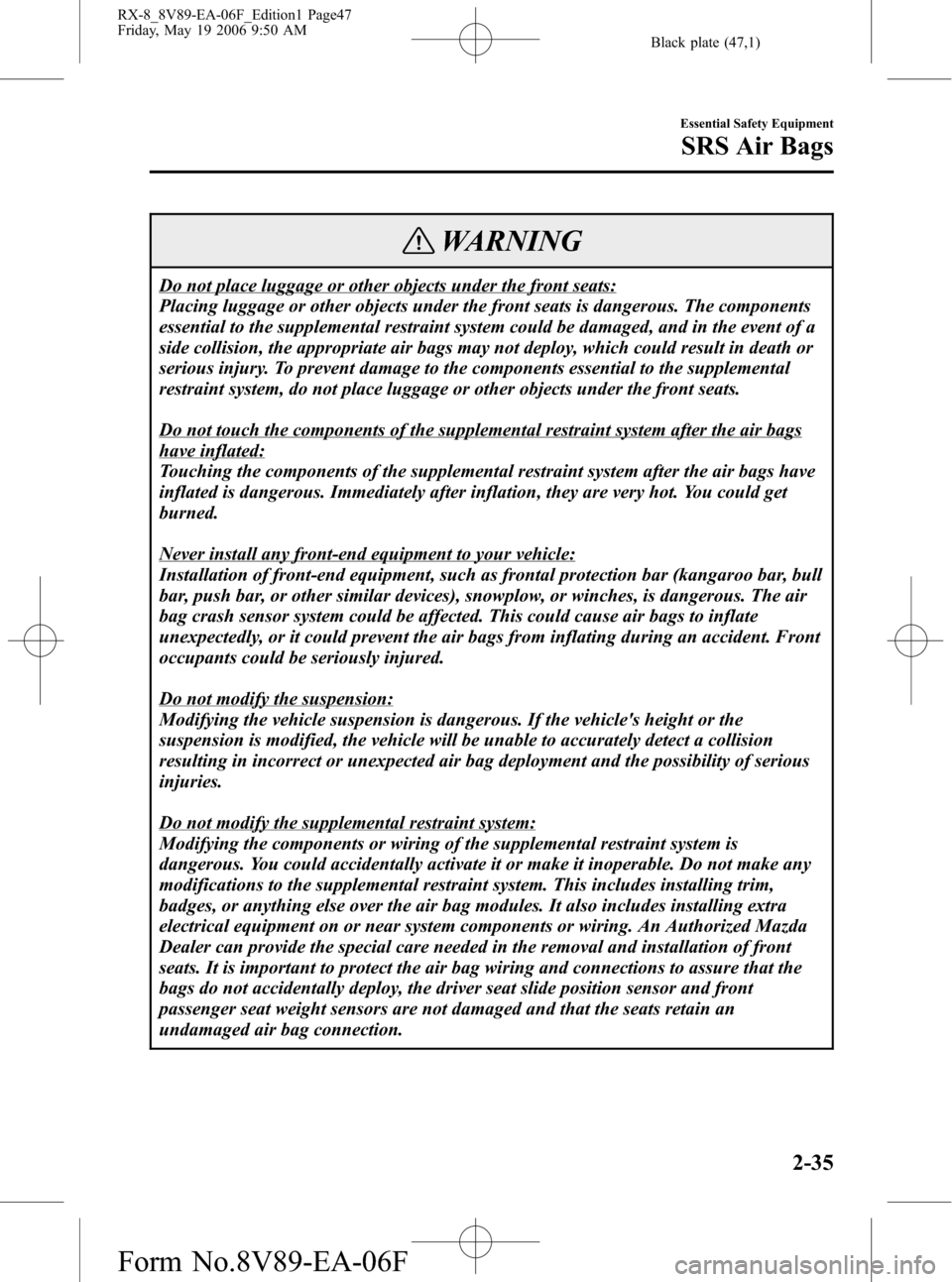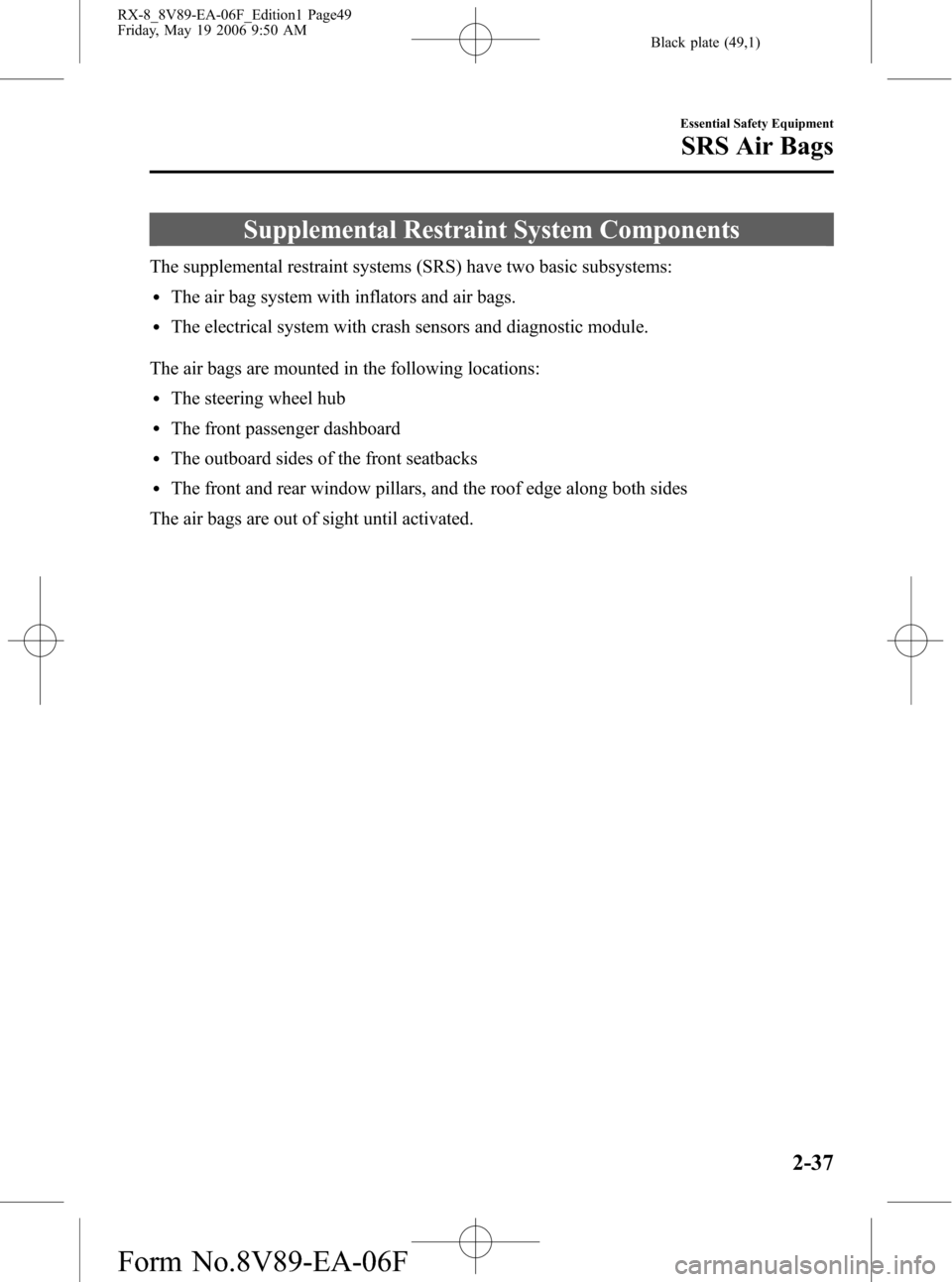sensor MAZDA MODEL RX 8 2007 Owners Manual (in English)
[x] Cancel search | Manufacturer: MAZDA, Model Year: 2007, Model line: MODEL RX 8, Model: MAZDA MODEL RX 8 2007Pages: 443
Page 16 of 443

Black plate (15,1)
Make sure the lever returns to its original
position and the seat is locked in place by
attempting to push it forward and
backward.
qSeat Recline
WARNING
Do not drive with the seats reclined:
Sitting in a reclined position while the
vehicle is moving is dangerous
because you don't get the full
protection from seat belts. During
sudden braking or a collision, you can
slide under the lap belt and suffer
serious internal injuries. For
maximum protection, sit well back and
upright.
Always sit in a passenger seat properly
with the seatback upright and feet on
the floor:
If your vehicle is equipped with front
passenger seat weight sensors, sitting
in the front passenger seat improperly
out of position or with the seatback
reclined too far while the vehicle is
moving is dangerous as it can take off
weight from the seat bottom and affect
the weight determination of the front
passenger sensing system. As a result
the front passenger will not have the
supplementary protection of the air
bag and seat belt pretensioner, which
could cause result in serious injury.
Always sit upright against your
seatback, with your feet on the floor.
WARNING
Do not drive with the seatback
unlocked:
The seatback plays an important role
in your protection in a vehicle.
Leaving the seatback unlocked is
dangerous as it can allow passengers
to be ejected or thrown around and
baggage to strike occupants in a
sudden stop or collision, resulting in
severe injury. After adjusting the
seatback at any time, even when there
are no other passengers, rock the
seatback to make sure it is locked in
place.
To change the seatback angle, lean
forward slightly while raising the lever.
Then lean back to the desired position and
release the lever.
Make sure the lever returns to its original
position and the seatback is locked in
place by attempting to push it forward and
backward.
Essential Safety Equipment
Seats
2-3
RX-8_8V89-EA-06F_Edition1 Page15
Friday, May 19 2006 9:50 AM
Form No.8V89-EA-06F
Page 19 of 443

Black plate (18,1)
qSeat Recline
WARNING
Do not drive with the seats reclined:
Sitting in a reclined position while the
vehicle is moving is dangerous
because you don't get the full
protection from seat belts. During
sudden braking or a collision, you can
slide under the lap belt and suffer
serious internal injuries. For
maximum protection, sit well back and
upright.
Always sit in a front passenger seat
properly with the seatback upright and
feet on the floor:
If your vehicle is equipped with front
passenger seat weight sensors, sitting
in the front passenger seat improperly
out of position or with the seatback
reclined too far while the vehicle is
moving is dangerous as it can take off
weight from the seat bottom and affect
the weight determination of the front
passenger sensing system. As a result
the front passenger will not have the
supplementary protection of the air
bag and seat belt pretensioner, which
could cause result in serious injury.
Always sit upright against your
seatback, with your feet on the floor.Change the seatback angle by pressing the
front or rear side of the reclining switch.
Release the switch at the desired position.
qHeight Adjustment
Front of seat bottom
To adjust the front height of the seat
bottom, raise or lower the front of the
slide lifter switch on the left side of the
seat.
2-6
Essential Safety Equipment
Seats
RX-8_8V89-EA-06F_Edition1 Page18
Friday, May 19 2006 9:50 AM
Form No.8V89-EA-06F
Page 27 of 443

Black plate (26,1)
qUnfastening the Seat Belt
Depress the button on the buckle. If the
belt does not fully retract, pull it out and
check for kinks or twists. Then make sure
it remains untwisted as it retracts.
Button
NOTE
If a belt does not fully retract, inspect it
for kinks and twists. If it is still not
retracting properly, have it inspected at
an Authorized Mazda Dealer.
Front Seat Belt Pretensioner
and Load Limiting Systems
For optimum protection, the driver and
front passenger seat belts are equipped
with pretensioner and load limiting
systems. For both these systems to work
properly you must wear the seat belt
properly.
Pretensioners:
In moderate or severe frontal or near-
frontal accidents, the front air bag and
pretensioner systems deploy
simultaneously when the seat belt is worn.
If the front seat occupant is not wearing a
seat belt, that person's pretensioner will
not fire even if the air bag does. The front
seat belt retractors remove slack quickly
as the air bags are expanding.
In addition, the pretensioner system for
the front passenger, like the front
passenger air bag, is designed to only
deploy in accordance with the total seated
weight on the front passenger seat. Any
time the air bags and seat belt
pretensioners have fired they must be
replaced. For details, refer to the front
passenger seat weight sensors (page 2-40).
Load limiter:
The load limiting system releases belt
webbing in a controlled manner to reduce
belt force on the occupant's chest. While
the most severe load on a seat belt occurs
in frontal collisions, the load limiter has
an automatic mechanical function and can
activate in any accident mode with
sufficient occupant movement.
Even if the pretensioners have not fired,
the load limiting function must be
checked by an Authorized Mazda Dealer.
2-14
Essential Safety Equipment
Seat Belt Systems
RX-8_8V89-EA-06F_Edition1 Page26
Friday, May 19 2006 9:50 AM
Form No.8V89-EA-06F
Page 32 of 443

Black plate (31,1)
Child Restraint Precautions
Mazda strongly urges the use of child-restraint systems for children small enough to use
them.
You are required by law to use a child-restraint system for children in the U.S. and Canada.
Check your local and state or provincial laws for specific requirements regarding the safety
of children riding in your vehicle.
Whatever child-restraint system you consider, please pick the appropriate one for the age
and size of the child, obey the law and follow the instructions that come with the individual
child-restraint system.
A child who has outgrown child-restraint systems should sit in the rear and use seat belts,
both lap and shoulder. If the shoulder belt crosses the neck or face, move the child closer to
the center of the vehicle.
Statistics confirm that the rear seat is the best place for all children up to 12 years of age,
and more so with a supplemental restraint system (air bags).
A rear-facing child-restraint system shouldNEVERbe used on the front seat with the air
bag system activated. The front passenger's seat is also the least preferred seat for other
child-restraint systems.
To reduce the chance of injuries caused by deployment of the front passenger air bag, the
front passenger seat weight sensors work as a part of the supplemental restraint system.
This system deactivates the front passenger front and side air bags and also the front
passenger seat belt pretensioner system when the total seated weight on the front passenger
seat is less than approximately 30 kg (66 lb).
When an infant or small child sits on the front passenger seat, the system shuts off the front
passenger front and side air bags and seat belt pretensioner system, so make sure the front
passenger air bag deactivation indicator light illuminates.
Even if the front passenger air bag is shut off, Mazda strongly recommends that children be
properly restrained and child-restraint systems of all kinds are properly secured on the rear
seats which are the best place for children.
For more details, refer to“Front passenger seat weight sensors”(page 2-40).
Essential Safety Equipment
Child Restraint
2-19
RX-8_8V89-EA-06F_Edition1 Page31
Friday, May 19 2006 9:50 AM
Form No.8V89-EA-06F
Page 34 of 443

Black plate (33,1)
WARNING
Do not install a front-facing child-restraint system on the front passenger seat unless
it is unavoidable:
In a collision, the force of a deploying air bag could cause serious injury or death to
the child. If installing a front-facing child-restraint system on the front passenger seat
is unavoidable, move the front passenger seat as back as possible.
Seating a child in a child-restraint system on the front passenger seat is dangerous:
Vehicles equipped with front passenger seat weight sensors are also equipped with a
front passenger air bag deactivation indicator light (page 2-27). Even with the front
passenger seat weight sensors, if you must use the front passenger seat for children,
seating a child in a child-restraint system on the front passenger seat under the
following conditions increases the danger of the front passenger air bag deploying
and could result in serious injury or death to the child.
lThe total seated weight of the child with the child-restraint system on the front
passenger seat is approximately 30 kg (66 lb) or more with a child in the child-
restraint system.
lLuggage or other items are placed on the seat with the child in the child-restraint
system.
lA rear passenger or luggage push or pull down on the front passenger seatback.lA rear passenger puts their feet on the front seat rails.lLuggage or other items are placed on the seatback or hung on the head restraint.lThe seat is washed.lLiquids are spilled on the seat.lThe front passenger seat is moved backward, pushing into luggage or other items
placed behind it.
lThe front passenger seatback contacts the rear seat.lLuggage or other items are placed between the front passenger seat and driver seat.lAny accessories, which might increase the total seated weight on the front
passenger seat, are attached to the front passenger seat.
The designated positions with seat belts on the rear seats are the safest places for
children. Always use seat belts and child restraints.
Essential Safety Equipment
Child Restraint
2-21
RX-8_8V89-EA-06F_Edition1 Page33
Friday, May 19 2006 9:50 AM
Form No.8V89-EA-06F
Page 36 of 443

Black plate (35,1)
Installing Child-Restraint
Systems
Accident statistics reveal that a child is
safer in the rear seat. The front passenger's
seat is clearly the worst choice for any
child under 12, and with rear-facing child-
restraint systems it is clearly unsafe due to
air bags.
Some child-restraint systems now come
with tethers and therefore must be
installed on the seats that take tethers to
be effective. In your Mazda, tethered
child-restraint systems can only be
accommodated in the two positions on the
rear seat.
Even if your vehicle is equipped with
front passenger seat weight sensors (page
2-40), which automatically deactivates the
front passenger air bag, a rear seat is the
safest place for a child of any age or size.
Some child-restraint systems also employ
specially designed LATCH attachments;
refer to“LATCH Child-Restraint
Systems”(page 2-29).
WARNING
Tethered Child-Restraint Systems
Work Only on Tether-Equipped Rear
Seats:
Installation of a tether equipped child-
restraint system in the front
passenger's seat defeats the safety
design of the system and will result in
an increased chance of serious injury
if the child-restraint system goes
forward without benefit of being
tethered.
Place tether equipped child-restraint
systems where there are tether
anchors.
qRear Seat Child-Restraint System
Installation
Follow these instructions when using a
child-restraint system, unless you are
attaching a LATCH-equipped child-
restraint system to the rear LATCH lower
anchors. Refer to“LATCH Child-
Restraint Systems”(page 2-29).
NOTE
Follow the child-restraint system
manufacturer's instructions carefully. If
you are not sure whether you have a
LATCH system or tether, check in the
child-restraint system manufacturer's
instructions and follow them
accordingly. Depending on the type of
child-restraint system, it may not
employ seat belts which are in
automatic locking mode.
Essential Safety Equipment
Child Restraint
2-23
RX-8_8V89-EA-06F_Edition1 Page35
Friday, May 19 2006 9:50 AM
Form No.8V89-EA-06F
Page 38 of 443

Black plate (37,1)
WARNING
Use the tether and tether anchor only
for a child-restraint system:
Using the tether or tether anchor to
secure anything but a child-restraint
system is dangerous. This could
weaken or damage the tether or tether
anchor and result in injury.
Always attach the tether strap to the
correct tether anchor position:
Attaching the tether strap to the
incorrect tether anchor position is
dangerous. In a collision, the tether
strap could come off and loosen the
child-restraint system. If the child-
restraint system moves it could result
in death or injury to the child.
qIf You Must Use the Front Seat
for Children
If you cannot put all children in the rear
seat, at least put the smallest children in
the rear and be sure the largest child up
front uses the shoulder belt over the
shoulder.
NEVER put a rear-facing child-restraint
system on the front passenger seat, even
with a seat weight sensor equipped
vehicle.
This seat is also not set up for tethered
child-restraint systems, put them in one of
the rear seat positions set up with tether
anchors.
Likewise the LATCH child-restraint
system cannot be secured in the front
passenger's seat and should be used in the
rear seat.
Don't allow anyone to sleep against the
side window if you have an optional side
and curtain air bag, it could cause serious
injuries to an out of position occupant. As
children more often sleep in cars, it is
better to put them in the rear seat. If
installing the child-restraint system on the
front seat is unavoidable, follow these
instructions when using a front-facing
child-restraint system in the front
passenger's seat.
Essential Safety Equipment
Child Restraint
2-25
RX-8_8V89-EA-06F_Edition1 Page37
Friday, May 19 2006 9:50 AM
Form No.8V89-EA-06F
Page 48 of 443

Black plate (47,1)
WARNING
Do not place luggage or other objects under the front seats:
Placing luggage or other objects under the front seats is dangerous. The components
essential to the supplemental restraint system could be damaged, and in the event of a
side collision, the appropriate air bags may not deploy, which could result in death or
serious injury. To prevent damage to the components essential to the supplemental
restraint system, do not place luggage or other objects under the front seats.
Do not touch the components of the supplemental restraint system after the air bags
have inflated:
Touching the components of the supplemental restraint system after the air bags have
inflated is dangerous. Immediately after inflation, they are very hot. You could get
burned.
Never install any front-end equipment to your vehicle:
Installation of front-end equipment, such as frontal protection bar (kangaroo bar, bull
bar, push bar, or other similar devices), snowplow, or winches, is dangerous. The air
bag crash sensor system could be affected. This could cause air bags to inflate
unexpectedly, or it could prevent the air bags from inflating during an accident. Front
occupants could be seriously injured.
Do not modify the suspension:
Modifying the vehicle suspension is dangerous. If the vehicle's height or the
suspension is modified, the vehicle will be unable to accurately detect a collision
resulting in incorrect or unexpected air bag deployment and the possibility of serious
injuries.
Do not modify the supplemental restraint system:
Modifying the components or wiring of the supplemental restraint system is
dangerous. You could accidentally activate it or make it inoperable. Do not make any
modifications to the supplemental restraint system. This includes installing trim,
badges, or anything else over the air bag modules. It also includes installing extra
electrical equipment on or near system components or wiring. An Authorized Mazda
Dealer can provide the special care needed in the removal and installation of front
seats. It is important to protect the air bag wiring and connections to assure that the
bags do not accidentally deploy, the driver seat slide position sensor and front
passenger seat weight sensors are not damaged and that the seats retain an
undamaged air bag connection.
Essential Safety Equipment
SRS Air Bags
2-35
RX-8_8V89-EA-06F_Edition1 Page47
Friday, May 19 2006 9:50 AM
Form No.8V89-EA-06F
Page 50 of 443

Black plate (49,1)
Supplemental Restraint System Components
The supplemental restraint systems (SRS) have two basic subsystems:
lThe air bag system with inflators and air bags.
lThe electrical system with crash sensors and diagnostic module.
The air bags are mounted in the following locations:
lThe steering wheel hub
lThe front passenger dashboard
lThe outboard sides of the front seatbacks
lThe front and rear window pillars, and the roof edge along both sides
The air bags are out of sight until activated.
Essential Safety Equipment
SRS Air Bags
2-37
RX-8_8V89-EA-06F_Edition1 Page49
Friday, May 19 2006 9:50 AM
Form No.8V89-EA-06F
Page 51 of 443

Black plate (50,1)
qFront Air Bag System Components
(1)
(6)
(10)
(7)(6) (9)(5) (4) (3) (2)
(8)
(1) Driver seat slide position sensor (page 2-40)
(2) Front seats
(3) Front dual stage inflators and air bags
(4) Front air bag sensor
(5) Front passenger air bag deactivation indicator light (page 2-40)
(6) Front seat belt pretensioner and load limiting systems (page 2-14)
(7) Front passenger seat weight sensors (page 2-40)
(8) Front passenger seat weight sensor control module
(9) Crash sensors and diagnostic module (SAS unit)
(10) Driver and front passenger seat belt buckle switches (page 2-40)
2-38
Essential Safety Equipment
SRS Air Bags
RX-8_8V89-EA-06F_Edition1 Page50
Friday, May 19 2006 9:50 AM
Form No.8V89-EA-06F